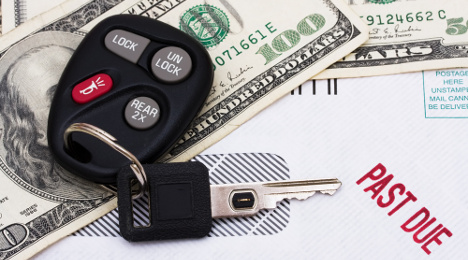Stemming from subprime financing activity, TransUnion’s Q2 Industry Insights Report showed the magnitude of diminishing originations and rising delinquencies.
Or as Brian Landau, senior vice president and automotive business leader for TransUnion, explained it to SubPrime Auto Finance News this week: “This is just normal course of the industry recalibrating.”
For the first time since 2012, TransUnion found that originations to subprime consumers declined year-over-year for a number of major credit products, including auto financing. The report, powered by Prama analytics, determined that 4.63 million subprime consumers originated a vehicle installment contract or lease, personal loan or credit card in Q1. Comparatively, 4.89 million subprime consumers originated one of these products in Q1 2016.
“Across product lines, we saw a decline in subprime originations at the beginning of 2017, and for the first time in a number of years we observed this for consecutive quarters,” said Ezra Becker, senior vice president of research and consulting for TransUnion.
“Immediately following the recession, many lenders pulled back on subprime originations to control delinquency,” Becker continued in a news release. “As the economy recovered, lenders loosened their underwriting standards and allowed more subprime consumers greater access to credit.
“It appears that this trend may now be changing, though it is a much different environment than what we observed just after the recession. The economy is performing well, and after several years of increased subprime lending, some lenders may simply be taking a pause,” Becker went on to say.
When it comes to consumers being behind on their monthly payments, TransUnion’s latest Industry Insights Report found that the auto delinquency rate reached 1.23 percent in Q2 of this year, an increase of 10.8 percent from 1.11 percent in Q2 of 2016.
“For the past several years, lenders have offered more financing opportunities to non-prime consumers,” Landau said. “As a result, we expected to see a slight rise in delinquency. It’s important to note that we still remain at very low levels of auto delinquency, but we will continue to monitor this trend.
“This is the normal course of what to expect to happen next,” Landau added during a phone conversation ahead of the report’s release. “Right now we’re seeing lenders more prudent and proactive in terms of scaling back to manage the risk, more so than they probably did in 2008. That is playing out right now. It didn’t surprise me that the uptick showed up on the most recent quarter. I’m sure if you talked to many lenders, they would say that they continue to fine tune and calibrate the managed risk in their portfolio. This may be going on for another few quarters.”
Among finance companies that report their results publicly, a few have pointed to the 2015 vintage as a potential source of their delinquencies. SubPrime Auto Finance News also asked Landau about what TransUnion’s data shows regarding the performance of paper originated at that time.
“When I look at our analysis of vintages going back to 2010, you see the deterioration of loan performance throughout the years,” Landau said. “We’re seeing this migration in terms of the uptick in delinquencies. That trend continues.
“What I could say about 2015, in particular, (is that) there were some macro-effects that could have impacted that particular vintage,” he continued. “We talked about the oil shock in states like Texas and Oklahoma where there is a high penetration of subprime and non-prime. The performance of the loans originated in those states was a little bit not on par with the others. That could be one reason for it.”
Viewed one quarter in arrears, TransUnion indicated auto finance originations declined to 6.73 million in Q1, down 2.9 percent from 6.93 million in Q1 2016. This marks the third consecutive quarter of year-over-year declines in auto originations and the first decline in origination growth in any first quarter since 2010.
“Lenders have also raised concerns about the downward pressure on used-car values, and we are beginning to see this impact origination growth,” Landau said. “Despite this decline, total auto balances continued to increase in the second quarter of 2017.”
Total auto balances achieved a new high in Q1, reaching $1.145 trillion, according to the report. The total balance was up 6.9 percent from $1.072 trillion in Q1 2016.
Personal loan activity
Another segment where subprime activity is prevalent is within personal loans as some auto finance companies have a division that caters to this space, too.
In Q1, TransUnion determined subprime personal loan originations declined 10.6 percent year-over-year, compared to a positive annual growth rate of 11.0 percent in Q1 2016. This development marks three straight quarters of year-over-year declines in originations.
More than 100,000 fewer subprime consumers opened a personal loan in Q1 2017 than in Q1 2016, according to TransUnion.
In fact, the credit bureau pointed personal loan originations declined for all risk tiers, but at lower rates than for subprime originations. Total originations dropped 6.9 percent from 2.99 million in Q1 2016 to 2.78 million in Q1 2017.
“A combination of factors have influenced the decline in subprime personal loan originations. For example, FinTech lenders faced funding challenges in Q2 2016,” Becker said.
“After years of growth in auto lending for subprime consumers, not surprisingly we observed an uptick in auto delinquency. Higher delinquency rates have long been anticipated as the result of that credit expansion. The reduction in subprime auto lending is a natural reaction to the emergence of that increased delinquency,” he continued.
In the second quarter of this year, the personal loan delinquency rate declined to the lowest level since 2009. The delinquency rate was 3.02 percent in Q2, an 8.5 percent decline from 3.30 percent in Q2 of last year.
“After a difficult 2016 for many FinTech lenders, we observed growth and stabilization in key metrics such as balances, delinquency and consumer participation,” said Jason Laky, senior vice president and consumer lending business leader for TransUnion. “More than 16 million consumers now have a personal loan, and we expect this trend to continue as more banks and credit unions re-enter the personal loan market.”
Personal loan balances achieved a new milestone of nearly $107 billion in Q2, growing 10.8 percent above the same point a year ago when total balances were $96 billion.
While balances increased, the growth rate was lower than the average Q2 growth rate of 24.7 percent for the past three years. The average balance per consumer also reached a new high at $7,781 in the second quarter, up slightly from $7,745 in Q2 2016.
“The personal loan market continues to grow, but with the pullback in non-prime originations offset by a shift toward prime plus and super prime consumers,” Laky said.
“At the beginning of 2017, the larger loans taken by the most creditworthy consumers helped drive balance growth and higher average borrower debt, while lowering overall delinquency,” he went on to say.
We often report on the delinquency rates of vehicle installment contracts held by consumers. Later this week, TransUnion plans to share its second-quarter data with SubPrime Auto Finance News.
But what about the repayment activity by dealerships associated with the commercial financing business? While there doesn’t appear to be industry-wide data available like what’s generated by TransUnion as well as Experian and Equifax on the consumer side, the Q2 updates from General Motors Financial as well as KAR Auction Services give at least a little sense of what might be happening in that part of the credit world.
First, let me start with GM Financial, which stated in its Q2 report that its total global receivables in the commercial space stood at $9.7 billion. Chief executive officer and president Dan Berce told investment analysts “commercial lending has experienced steady growth in the U.S." A year earlier, the overall figure stood at $6 billion.
Berce noted that GM Financial had 827 dealers in the U.S., leveraging its commercial services as of the close of the second quarter, a 25-percent lift above the same point a year earlier.
As far as those dealers maintaining their commitments, GM Financial reported that its allowance for losses as a percentage of commercial finance receivables, net of fees, remained at 0.5 percent on June 30; the same figure as the close of 2016.
Meanwhile over at KAR, activity at Automotive Finance Corp. offered a slightly different perspective on the commercial-space story.
The company reported AFC’s Q2 revenue declined by 4 percent in part because management increased the provision for credit losses to 2.6 percent, up from 1.3 percent a year earlier. That uptick translated to $6 million, according to KAR Auction Services chairman and chief executive officer Jim Hallett.
“As I look at AFC, we continue to operate our finance company very conservatively. The number of loan transactions was relatively flat,” Hallett told attendees on the company’s quarterly conference call. “The provision for credit losses was 2.6 percent of average loan balances for the quarter. We’ve told you that we expect lower loan losses in the second half of the year.
“While the second-quarter loan losses were up as expected, I have good news to discuss within the quarter,” he continued. “The loss provision was high in April and May as we ran off the defaulted loans that we had discussed on previous calls. Our June provision for credit losses was below our expected loss rates of 1.75 percent to 2.25 percent of our average receivables, as the credit quality of our portfolio has continued to improve.
“This is a very good indicator for what we expect to see in the second half of 2017,” Hallett went on to say.
While Hallett made those assessments during the opening portion of KAR’s call, Wall Street watchers continued to probe about the health of AFC’s portfolio and dealerships’ ability to maintain their floor plan payments. AFC’s total managed receivables softened slightly year-over-year to $1.736 billion.
“Listen, what happened for these higher loan losses were a very small number of dealers with larger credits that probably misjudged what was happening to used-car prices at the higher end of the market,” KAR Auction Services executive vice president and chief financial officer Eric Loughmiller responded.
“I think they just caught with inventory that had some depreciation in terms of prices falling, and maybe they got caught with inventory that was overpriced at the wholesale market,” Hallett interjected. “But I think the other thing that’s important to point out here is that the independent dealer is still doing quite well.
“The independent dealer year-over-year is showing an increase in the total number of used-car sales. So, it's still a very healthy market and a very healthy group of dealers. And I’ll just repeat what Eric said, I think this was just a very small group of dealers that really got over their skies on some of their buying and got caught with that heavy inventory,” Hallett went on to say.
So perhaps just like some car buyers who take on too much debt and end up in delinquency, a few dealers ended up in a similar kind of financial pickle when acquiring inventory, at least if some of the AFC figures and anecdotes from Hallett and Loughmiller are any indication.
As we all watch the movements of wholesale prices and retail sales for the remainder of the year, it might be worth keeping an eye on commercial financing activity, too. Not intending to pull any fire alarms here, but if both dealers and vehicle contract holders begin to fall behind en masse, it’s going to be finance companies left to look for collateral in the driveway — and maybe the showroom, too.
Nick Zulovich is senior editor of SubPrime Auto Finance News and can be reached at [email protected].
Nicholas Financial acknowledged two elements combined to erode its originations during its most recent quarter that closed on June 30, but the subprime auto finance company is remaining steadfast in its strategy to maintain discipline during challenging market conditions.
The figures Nicholas Financial reported included diluted earnings per share decreasing 73 percent to $0.10 as compared to $0.37 for the three months ended last June 30. The company’s net earnings were $0.8 million and $2.9 million as of that date in 2017 and 2016, respectively.
The company also indicated quarterly revenue dropped 3 percent to $22.2 million.
Nicholas Financial explained net earnings were adversely affected primarily by an increase in the provision for credit losses due to higher charge-offs and past-due accounts along with a reduction in the gross portfolio yield. The company’s total delinquency rate stood at 12.2 percent at the close of the last quarter, up from 7.66 percent a year earlier. The total outstanding balance associated with those delinquent contracts that range from 31 days past due to more than 90 days rose to $58.18 million, which constitutes a jump from $37.05 million a year ago.
And the company’s net charge-off percentage rose from 7.51 percent to 9.54 percent.
“Additionally, several negative factors continue to put pressure on our net earnings, including an extremely competitive market, higher than expected losses and a continuous decline in auction proceeds,” Nicholas Financial said in its quarterly report. “We remain cautious with respect to near-term losses as delinquency percentages remain elevated.”
Meanwhile, originations tumbled in the most recent quarter, too.
Nicholas Financial purchased 2,349 contracts in the quarter that finished on June 30 worth $27.16 million. During the comparable three-month span last year, the company originated 3,517 contracts representing $40.83 million in outstanding balances.
Many of the other metrics associated with the company’s latest originations remained similar year-over-year, including:
—APR: 22.31 percent as compared to 22.39 percent
—Average discount: 7.56 percent as compared to 7.15 percent
—Average term: 55 months as compared to 57 months
—Average balance: $11,563 as compared to $11,609
Nicholas Financial held a total of 36,174 active contracts as of June 30.
“Throughout this past quarter, we continued to experience intense competition from existing market participants. During this same time period, automobile dealerships, which the company conducts business with, have reported declining sales," Nicholas Financial president and chief executive officer Ralph Finkenbrink said, who announced his retirement would come when the company closes its fiscal year on Sept. 30.
“The combination of robust competition, fewer applications received by the company for potential loan approval and recent changes by the company to its underwriting guidelines has led to a 33-percent reduction in contracts acquired during the three months ended June 30 as compared to the three months ended June 30, 2016,” Finkenbrink continued.
“We will not expand the number of contracts purchased by incurring risk that are not priced appropriately and not conducive to providing long-term sustainable value. These ongoing market conditions require us to gain momentum regarding our ability to adapt to a competitive cycle that, for the foreseeable future, gives no indication of subsiding,” he went on to say.
“For us, that involves further evaluation of our current business structure, as well as, our overall operating strategy,” Finkenbrink added.
Digital Recognition Network (DRN) hosted its annual affiliate appreciation event during last month’s North American Repo Summit (NARS) to honor DRN providers and affiliates. The event included an awards ceremony where DRN recognized companies that have demonstrated excellence and shown leadership in the repossession industry.
The winners included providers American Recovery Service (ARS) and ALS Resolvion, as well as affiliates Connect One, International Recovery Systems, Professional Auto Recovery, Relentless Recovery, Specialized Towing and Recovery and Source One.
“We are proud to partner with some of the hardest working leaders in the repossession industry,” said Andy Cameron, vice president of data recovery at DRN. “These providers and affiliates are constantly working and innovating to ensure that their lenders receive the best results. These companies help to set the standard for the industry and these awards recognize their contributions.”
American Recovery Service (ARS) was named the Provider of the Year due to the company’s high number of total repossession assignments and successful repossessions. ARS saw a high network effective rate and monthly inputs for the year, adding to their value as a forwarder.
Since 2009, the relationship between DRN and ARS has resulted in nearly 250,000 vehicle recoveries, returning billions in asset value for auto finance customers.
Provider ALS Resolvion (ALS) received the Hard Charger award, which is presented to the companies who has exhibited high growth in the past year. In this year alone, ALS experienced a high growth rate of approximately 67 percent in assignments, inputs and repossessions.
“We are appreciative of DRN for the recognition and award. It’s a testament to our commitment to providing our clients the premier live LPR service in the marketplace,” ALS Resolvion president Jose Mendiola said.
“DRN’s data is second to none. When combined with ALSR’s state of the art system and 24/7 service center, our clients can expect superior results,” Mendiola continued.
DRN also celebrated and honored repossession affiliates at the event, presenting Connect One, Professional Auto Recovery and Specialized Towing and Recovery with the Top Gun Award, which recognizes affiliates that have shown excellence throughout the past year. All three companies are national leaders in the repossession industry, and have had a positive impact in the markets they serve.
Additional affiliates honored included Relentless Recovery, International Recovery Systems and Source One.
Relentless Recovery was awarded with the Big Picture Award. This past year, the company successfully implemented new technology and best practices to aid in their recovery process, helping them become leaders in its market.
The Up and to the Right Award was presented to International Recovery Systems, who continues to be a leader in their market through their upward business trajectory.
Source One was recognized with the Hottest Out of the Gate award, presented to a new affiliate that shows remarkable growth and market impact.
“We are pleased to recognize our affiliates for their hard work and commitment to DRN and to the industry,” Cameron said. “They have all provided exceptional service and consistently demonstrate leadership in serving the repossession industry.”
The next series of free skip-tracing training webinars hosted by Alex Price, the director of risk solutions at Digital Recognition Network (DRN), begins this week.
An expert in skip-tracing with more than 30 years of experience, Price is beginning this quartet of 45-minute training sessions on Wednesday at 2 p.m. ET. Among the points Price plans to cover, he will share tips on identifying the right person to talk to while asking them the right questions.
Price then intends to share recommendations on how to drive the conversation while developing location and leads from little information.
Here is the complete rundown of all four segments of Price’s skip-tracing series:
—Part 1: Skip-tracing interview tactics — Wednesday at 2 p.m. ET
—Part 2: Tools of a skip-tracer — Sep. 13 at noon ET
—Part 3: Old-school meets new-school skip-tracing — Oct. 11 at 2 p.m. ET
—Part 4: Creating a skip persona from LPR data — Nov 15 at 2 p.m. ET
Finance company managers and other personnel involved in collections and recoveries can register for any or all of these sessions.
Consumer Portfolio Services chairman and chief executive officer Brad Bradley described how the subprime finance company is going through what he called a “painful process.” While the company’s originations are down from last year, its delinquencies didn’t spike to alarming levels.
Rather, Bradley is leading CPS with patience even though Q2 originations edged up slightly on a sequential comparison but softened by nearly $100 million compared to a year earlier.
During the second quarter, CPS reported that it purchased $233.9 million of new contracts compared to $229.6 million during Q1 and $319.1 million during the second quarter of last year. The company's managed receivables totaled $2.343 billion as of June 30, an increase from $2.323 billion as of March 31 and $2.254 billion as of the end of last June 30.
“I think people probably at this point understand what we’re trying to do,” Bradley said during closing comments of CPS’ latest conference call. “I mean people who know the company and certainly know me know that we would rather be aggressive. We would rather be actively growing the company and moving forward in the world. So this is a bit of a painful process for us right now.
“But to the extent you go back to 2007 when we had a huge problem, these times that are being a little more conservative might give you a huge home run later,” he continued. “And so what we don't want to do is stick our neck out with the rest of the folks and have a problem. So we've been pretty good at avoiding them. We think we've done a lot of things right now. As we mentioned in the call, it may take a few minutes or little while to prove that out. But we have some time to do it.
“And with any luck, we’ll position ourselves very well for the next couple of years, if we just staying in there patiently for the next few quarters. And that’s what we’ve been trying to do, and certainly we are achieving that goal today. Painful hurt, maybe for some of us, who like to see the company moving surging forward rather sitting in idle. But that’s the course we’ve chosen, and we think it’s a life course, and we’ll see what happens in the next few quarters,” Bradley went on to say.
CPS generated nearly a 5 percent year-over-year increase in revenue as it rose by $5.1 million to $110.1 million. However, the company’s total operating expenses jumped 10.3 percent or $9.5 million to $102.1 million. As a result, CPS watched its Q2 earnings drop to $4.6 million, or $0.17 per diluted share, down from $7.3 million, or $0.25 per diluted share a year earlier.
While all of those metrics shifted, CPS still managed to posts its 24th consecutive quarter of positive earnings.
Overall industry view
As he often does, Bradley shared his candid assessment of how the market is behaving. His view of competition focused a bit on the strides credit unions have made in gaining market share, especially as some finance companies are backing off their origination aggression.
According to the latest information from Experian Automotive, credit unions held 20 percent of the total auto finance market after the first quarter, up from 18 percent a year earlier.
“Credit unions have done a big job of moving into the spaces in the bottom of the spectrum, and been relatively competitive in growing in this sector in the last year or two,” Bradley said. “Some of the companies are pulling back,. Some of the companies are slowing down, and a lot of that gap is being filled by some of these credit unions.”
Another topic Bradley touched on was income verification. He emphasized that CPS’ underwriting department checks consumers’ income sources before finalizing the contract.
“We do verify income in every single deal,” Bradley said. “Job verification or income verification obviously was a hot topic in the news last few quarters. It’s ironic that that isn’t more the norm in the industry, but for us it is. It’s not bad when people ask questions, and we have a really good answer.”
Other company metrics
In other parts of CPS’ latest financial statement, the company reported annualized net charge-offs for the second quarter were 7.62 percent of the average owned portfolio as compared to 6.94 percent a year earlier.
CPS also reported delinquencies greater than 30 days (including repossession inventory) stood at 9.64 percent of the total owned portfolio as of June 30, up from 8.58 percent on the same date in 2016.
And if contracts do not mature, Bradley mentioned the loan-to-value ratios CPS is pushing into its portfolio are improving. After hitting a high of 115 percent, Bradley mentioned the stat dipped to 112.74 percent in Q2.
CPS chief financial officer Jeffrey Fritz also mentioned the company enjoyed a slight year-over-year improvement in its recovery rate through its wholesale endeavors after repossession, watching the rate tick up to 35.6 percent from 35.2 percent.
In the second quarter, the company’s board of directors approved an increase to the aggregate authorization to repurchase outstanding securities by $10 million. In Q2, CPS purchased 540,793 shares of stock in the open market at an average price of $4.54. Through the first six months of the year, CPS purchased 1,102,410 shares at an average price of $4.74.
License plate recognition (LPR) software and data solutions provider MVTRAC on Tuesday announced the closing of growth recapitalization of the company with Bison Capital Asset Management along with changes to its top leadership structure.
MVTRAC shared Bison Capital’s investment will allow MVTRAC to accelerate its growth by expanding its sales and client service resources to enhance its technology suite and pursue acquisitions. With the investment, MVTRAC founder Scott Jackson will remain on as chairman of the board. The current MVTRAC president Luke Smith will be named the company’s senior executive officer.
MVTRAC has established a national network of agents utilizing MVTRAC’s solutions along with one of the largest LPR databases and analytics labs serving the auto financing market. By focusing on providing high-quality customer service, training and support for its innovative LPR solutions, MVTRAC can enable its customers to demonstrably improve their recovery rates, reduce days-to-recovery and increase their profitability.
Additionally, MVTRAC’s integrated business process management software can help its customers improve compliance with regulatory and client requirements by automating verification and documentation, and minimizing human contact in the auto location and recovery process. These advantages have allowed MVTRAC to maintain its impressive customer satisfaction and retention rates, as well as continue to scale its national network of agents and LPR database.
As a result, MVTRAC is uniquely positioned to service the portfolio requirements of the largest financial institutions in auto financing. Bison Capital’s growth investment will be used to help add new auto financing companies, expand its national network of asset recovery agencies and strengthen its portfolio of LPR technology and software solutions.
“Our management team is excited for the opportunity to partner with a supportive, forward-thinking investment firm of Bison’s caliber,” Smith said. “A common vision for the strategic direction and vast potential of MVTRAC was the primary driver behind our partnership, and we are confident that this alignment will significantly augment MVTRAC’s mission to provide our customers with high-utility, innovative LPR data and technology solutions across a multitude of platforms.”
Bison Capital partner Andreas Hildebrand added, “We are excited to be partnering with MVTRAC and its outstanding management team as they continue to enhance their innovative line of LPR products and services and expand their market presence.
“MVTRAC has established tremendous momentum in the LPR space and we look forward to helping it realize its full potential in this unique market,” Hildebrand added.
Jackson shared a similar positive outlook regarding the future of the organization that he founded.
“After 27 years of building the business to its current position as an industry leader with a rapid growth trajectory, it is time for me to begin enjoying life as a recovering workaholic,” Jackson said. “I have absolute confidence in Luke and the management team to expand on my vision for MVTRAC’s growth and consequently, it is our valued clients and agents that will benefit the most as MVTRAC continues to push the limits of LPR capabilities.
“While I will be stepping away from the daily operations of MVTRAC, the recapitalization will enable me to focus on M&A opportunities and expanding our dynamic intellectual property portfolio,” Jackson continued. “The opportunity to leverage Bison’s capital and resources to further accelerate MVTRAC’s growth is genuinely exciting.”
The relationship forged between Digital Recognition Network (DRN) and Pelican Auto Finance, a subprime auto finance company operating in California and Pennsylvania, is proving to be beneficial for both operations.
The companies shared this week that Pelican reports increased asset recovery rates, reduced charge-offs and avoided losses due to unreported stolen or impounded vehicles by leveraging DRNsights, which can combines DRN’s exclusive vehicle location data and analytics to help locate and recover assets finance companies sometimes rarely find, make right party contact to cure contracts, and locate legacy charge-offs.
“When customers begin avoiding contact, we need to find those vehicles as quickly as possible. DRNsights pays for itself because we are finding vehicles we otherwise weren’t able to, including legacy charge-offs where we had zero leads,” said Chris Mitcham, senior vice president of servicing and analytics at Pelican Auto Finance.
“We also use the Loss Alerts feature to notify us of impounded and stolen vehicles. With these alerts, we find out earlier that a vehicle is in impound, lost or has been stolen. Just one Loss Alert can result in significant dollars saved in impound fees or vehicle depreciation; and now we are finding four or five a month that we would have to wait on notification, meanwhile racking up fees or not have found at all,” Mitcham continued.
Pelican uses DRNsights daily in the collections and recovery processes. In collections, DRNsights can help confirm a customer’s given address and alerts Pelican about changes that may warrant action.
Using the vehicle location data, Pelican can identify new addresses to make right party contact.
“Having new addresses to make contact is especially important in early stage delinquency and can help avoid further delinquency or a repossession,” Mitcham said.
Once a vehicle is out for repossession, Pelican used DRNsights to help recover the vehicle faster. The finance company found that the data makes recovery efforts more efficient using vehicle location data to direct recovery agents to the right location, date and time for successful recovery.
As a result, Pelican said it immediately realized reduced charge-offs due to “skipped” accounts and is recovering more vehicles faster.
“DRNsights has revolutionized the repossession industry by helping lenders recover up to 35 percent more vehicles and avoid charge-off losses. Pelican’s results show the power of our data and analytics to mitigate risk and reduce losses,” said Jeremiah Wheeler, vice president financial services for DRN.
The system is powered by DRN’s vehicle location data and analysis, all of which is collected by a network of license plate recognition (LPR) cameras located nationwide. The data is instrumental in helping many finance companies in their collections process, providing alerts of possible risk, protection from lien losses, new locations for making contact on 40 percent or more accounts and the ability to collect earlier to reduce charge-offs, and a 50 percent reduction in days to recover vehicles out for repossession.
Stemming from an effort to unionize workers, Santander Consumer USA on Friday afternoon vehemently refuted claims contained in a report distributed by the AFL-CIO, National Employment Law Project and Committee for Better Banks about how the finance company’s collections department operates.
In a message to SubPrime Auto Finance News, SCUSA said, “the complaints cited in the ‘report’ misrepresent our work environment,” as one of the sources claimed to have 20 years of industry experience, including time with Santander until a year ago.
“Our customers and our employees are our top priorities, and we continuously review our consumer and business practices to ensure that we are providing responsible financing to consumers who want a vehicle to meet their personal needs,” SCUSA said in its statement. “Santander Consumer has zero tolerance for employee or dealer misconduct, and follows up on all documented employee complaints.
“We were particularly dismayed that the authors chose to mischaracterize ordinary, customer-friendly business practices — such as monitoring customer calls and providing scripts to our workers — as evidence of improper conduct,” Santander continued. “These practices are not only expected by our regulators, but are widely considered standard elements of best-in-class customer service and consumer practices.
“While Santander recognizes and respects the rights of its employees to unionize or not, as they choose under U.S. law, these assertions and mischaracterizations are yet another attempt by union organizers to unfairly discredit Santander to further their own agenda,” the company went on to say.
“Santander prides itself on having an employee-friendly workplace where our employees are respected and motivated and where direct, open and frequent communication between employees and management is encouraged,” the company added.
According to a news release SubPrime Auto Finance News received on Friday afternoon, the report titled, “Wheeling and Dealing Misfortune,” is based on research into Santander’s “extensive history of non-compliance” with consumer protection regulations and interviews with former and current Santander workers. One of the individuals who participated was Jerry Robinson, a 20-year veteran of the auto finance industry and member of the Committee for Better Banks who worked at Santander until 2016.
“When I first joined the industry, my managers encouraged me to listen to customers and address their specific needs, but at Santander, profit always came first,” Robinson said. “Our bonuses were tied to how many loans we could extend and how many cash-strapped customers we could put back in their repossessed cars with higher and higher interest rate loans.
“It made me sick to watch people dig themselves into tens of thousands of dollars in debt, but I knew if I failed to do these things I’d run the risk of disciplinary action that would likely end in termination because of the metric system,” he continued.
Earlier this week, the news release indicated workers from SCUSA’s collections department briefed the Consumer Financial Protection Bureau and members of Congress, including Sen. Elizabeth Warren, Sen. Cory Booker, Sen. Sherrod Brown and Rep. Mark Pocan. They reportedly discussed the report’s findings and recommended regulations to curb the “next subprime financial crisis.”
Report author Molly McGrath said, “Santander Consumer sets the trend for how auto loans are sold and serviced industry-wide. Yet for years, the bank has driven a race to the bottom with questionable banking practices disturbingly reminiscent of the 2008 subprime housing crisis.
“Until now, Santander Consumer has been operating largely in the dark, but the very workers forced to prey on vulnerable consumers are speaking out to demand accountability,” McGrath continued.
In interviews with current and former employees, the report indicated Santander collections workers detailed the finance company’s operations that the authors deemed to be “egregious practices that exploit people of color, seniors and low-income communities.” Examples included:
• To get paid, Santander collections workers had to meet an “ever-changing” set of metrics, based on the number of installment contracts reinstated, ability to collect on late payments, term extensions and speed of calls. One former collections worker shared, “We were under tremendous pressure. Santander did not want us to give (customers) too much information or assistance. They told us to stick to the script and get people to pay.”
• Santander collections workers had adhere to an “impersonal” script that report authors determined to blocks them from asking questions that would help customers “resolve problems quickly, efficiently and without going into further debt.” Calls were monitored through an automated system, CallMiner, which ranks employee tone. One current worker told Congressional staff, “If you do not use the right words or tone, CallMiner will score the call negative, which can result in discipline or termination. This leads to the employee concentrating more on scoring than on the customer.”
• The report stated CFPB complaints demonstrated that Santander customers frequently misunderstood what a term extension is and the fees associated with an extension. One employee reported seeing terms “with interest rates as high as 27 percent.” Another former employee said she often saw “extensions that had been added without even contacting the customer to get their consent.”
• When customers defaulted on contracts, Santander charges a daily penalty of $15 to $32, “often hidden from customers,” according to the report. Workers reported that managers would not push for repossession teams to pick up a vehicle after a customer had defaulted because every day it remained the per diem charges increased. One worker said that “customers would call me to beg me to send someone to pick up the car.”
Arnise Porter, a Committee for Better Banks organizer based in Dallas, said, “Santander capitalizes on low-income consumers’ desperation with high-interest loans designed to drive borrowers deeper and deeper into debt.
“And then they exploit their pressured workers by forcing them to push predatory loan extensions and hidden fees on customers when they inevitably default,” Porter added.
As experts and policymakers shared a variety of economic trend updates and observations, Fitch Ratings summarized that record-setting payment performance isn’t likely to simply last forever.
But at the same time, Fitch reiterated that deterioration of auto finance performance — especially in the subprime space — won’t pull the entire economy into a tailspin like some pontificators keep trying to allege.
In analysis released this week, Fitch acknowledged the continued financial resilience of the U.S. consumer has prolonged a period of “extremely strong” asset quality among many U.S. consumer lending segments. However, analysts insisted that U.S. consumer loan losses at financial institutions are at “unsustainable” cyclical lows and a more meaningful amount of credit deterioration should be expected over the near to medium term.
“This will particularly be the case should unemployment claims begin to reverse after reaching multi-decade lows,” Fitch said.
A month after the rate tied a 10-year low, S&P Dow Jones Indices and Experian released data through June on Tuesday and determined auto loan defaults decreased 3 basis points from the previous month to settle at a new low mark of 0.82 percent. The May reading had tied for the lowest mark analysts have seen during the past 10 years. In June 2015, the auto finance default rate also stood at 0.85 percent.
The new low record might not last, as the rate has made an upward movement from June into July during five of the past eight years. The most pronounced rise in the cyclical pattern arrived in the immediate aftermath of the Great Recession, when the rate in June 2009 of 2.18 percent jumped to 2.46 percent a month later.
Fitch explained the extent to which weaker credit performance will be a challenge for individual consumer lenders and finance companies will vary depending on the diversity of their activities and the extent to which they have strengthened capital and loss reserves to absorb higher losses. Analysts added their willingness to tighten underwriting standards in recent quarters in anticipation of a weaker macroeconomic environment will also be a key factor.
“Reflecting these dynamics, Fitch believes diversified banks are better positioned than mono-line lenders to weather meaningful erosion in consumer asset quality,” analysts said.
Fitch also pointed out that credit cards and auto loans — particularly retail credit cards and subprime vehicle installment contracts — will be the consumer loan segments most likely to see asset quality deterioration in the near to medium term. The firm noted higher loss rates and delinquencies have already begun to materialize.
“Drivers of weaker credit performance include stronger loan growth in recent years, increased competition leading to looser underwriting standards in the post-financial crisis period (including greater exposure to subprime borrowers) and, in the case of auto lending, residual values that have been supported by unsustainably high used vehicle prices,” analysts said.
According to Federal Reserve surveys, banks have begun tightening underwriting standards in both segments over the past several quarters.
“The potential systemic impacts of a rapid deterioration in either credit card or auto lending are limited relative to pre-crisis residential mortgage lending,” Fitch said. “Both segments are much smaller than residential mortgage debt with shorter loan durations and smaller loan balances.”
Ability to maintain payments
While Fitch referenced the impact unemployment might have on consumers’ ability to maintain their debt commitments, the latest analysis from Comerica Bank took a closer look at the latest federal employment report that indicated payroll employment increased by 222,000 net jobs in June.
Comerica Bank mentioned that revised figures for April and May triggered the unemployment rate to tick up slightly to 4.4 percent.
“This is not a sign of a cooling labor market. We expect that labor market conditions will continue to tighten through the second half of this year,” Comerica Bank chief economist Robert Dye said in the commentary.
Comerica also mentioned the average workweek inched up by one tenth of an hour to 34.5, and average hourly earnings increased moderately by 4 cents, or 0.2 percent.
“So this labor report hit the trifecta, showing that more workers worked longer hours and got paid more for it,” Dye said. “This is supportive of income growth in June and beyond and consumer spending, too.”
Comerica Bank maintained that despite this labor market data, the Federal Reserve is likely to leave interest rates where they currently are at 1.25 percent when the Federal Open Market Committee meets beginning on Tuesday. Dye is also projecting that the Fed will announce the beginning of balance sheet reduction at its September meeting and that another 0.25 interest rate rise should come in December.
During her semiannual appearance before the House Financial Services Committee, Federal Reserve chair Janet Yellen reiterated the strategy policymakers plan to leverage.
“The committee continues to expect that the evolution of the economy will warrant gradual increases in the federal funds rate over time to achieve and maintain maximum employment and stable prices,” Yellen said in her prepared testimony. “That expectation is based on our view that the federal funds rate remains somewhat below its neutral level — that is, the level of the federal funds rate that is neither expansionary nor contractionary and keeps the economy operating on an even keel.
“Because the neutral rate is currently quite low by historical standards, the federal funds rate would not have to rise all that much further to get to a neutral policy stance,” she continued. “But because we also anticipate that the factors that are currently holding down the neutral rate will diminish somewhat over time, additional gradual rate hikes are likely to be appropriate over the next few years to sustain the economic expansion and return inflation to our 2 percent goal.
“Even so, the committee continues to anticipate that the longer-run neutral level of the federal funds rate is likely to remain below levels that prevailed in previous decades,” Yellen went on to say.
And with regard to rate hikes the Fed already made, TransUnion’s analysis showed that most borrowers were able to absorb their increased monthly payment obligations after the Fed’s rate hike last December.
TransUnion’s study identified these 63 million consumers because they carried debts for which the minimum monthly payment due was tied to the market interest rate, such that a rise in rates from the December rate hike could cause an increase in payments required. TransUnion used its CreditVision aggregate excess payment (AEP) algorithm, which incorporates monthly payments from mortgages, credit cards and other debt obligations, to identify 10.6 million of these consumers who were at elevated risk of not having the capacity to absorb a rate increase of 0.25 percent.
The study then tracked the performance of these consumers through the end of March to give the December rate increase enough time to affect payment obligations. The study found that, in fact, only 1 million of these consumers were delinquent at the end of March. This was slightly lower than the study’s control group, who had no variable-rate products.
TransUnion explained this result implies that consumers with variable-rate credit were able to manage the rate increase as well as, or better than, consumers without variable-rate products.
“When we announced our ‘capacity to absorb a rate increase’ metric last May we said that it was a conservative measure of risk, in that it did not account for contributions to savings or investments that could be reallocated to cover debt service increases,” said Ezra Becker, senior vice president of research and consulting at TransUnion.
“We described our metric as an upper bound on the number of consumers who would struggle with a rate increase,” Becker continued. “We’re pleased to see that only 10 percent of those consumers we had considered at elevated risk of payment shock from a rate increase exhibited delinquency over the study period. Most consumers appeared able to reallocate their available cash, or make small changes to their spending habits, to effectively absorb the December rate increase.”
More about the overall economy
Fitch is maintaining its view that U.S. GDP growth will rise in 2017 and 2018.
“Increases in interest rates unaccompanied by meaningful economic growth and expanding wages could pressure consumer asset quality as it would result in increased debt service (for floating-rate obligations) and elevated refinancing risk without the benefit of higher income to absorb these costs,” analysts said.
“We believe that recent Fed rate hikes are part of long-term monetary policy normalization that is aligned with current macroeconomic conditions and the outlook,” they continued.
In the first quarter, Fitch mentioned U.S. consumer debt returned to its pre-crisis peak of $12.7 trillion after falling to a post-crisis low of $11.2 trillion in 2Q13. The student loan and auto segments have had the most pronounced increases, although credit card debt has also accelerated recently.
Between Q4 2008 and Q1 2017, Fitch calculated that student loan debt more than doubled to $1.3 trillion while auto finance balances increased by 48 percent to $1.2 trillion.
Over the same period, Fitch added that the much larger mortgage component of consumer debt declined by 6.8 percent to $8.6 trillion from a peak of $9.3 trillion, reflecting substantially tighter underwriting amid increased regulation and the exit of many non-bank lenders.
“Looking ahead, my colleagues on the FOMC and I expect that, with further gradual adjustments in the stance of monetary policy, the economy will continue to expand at a moderate pace over the next couple of years, with the job market strengthening somewhat further and inflation rising to 2 percent,” Yellen told House lawmakers.
“This judgment reflects our view that monetary policy remains accommodative,” she continued. “Ongoing job gains should continue to support the growth of incomes and, therefore, consumer spending; global economic growth should support further gains in U.S. exports; and favorable financial conditions, coupled with the prospect of continued gains in domestic and foreign spending and the ongoing recovery in drilling activity, should continue to support business investment.
“These developments should increase resource utilization somewhat further, thereby fostering a stronger pace of wage and price increases,” Yellen added.












